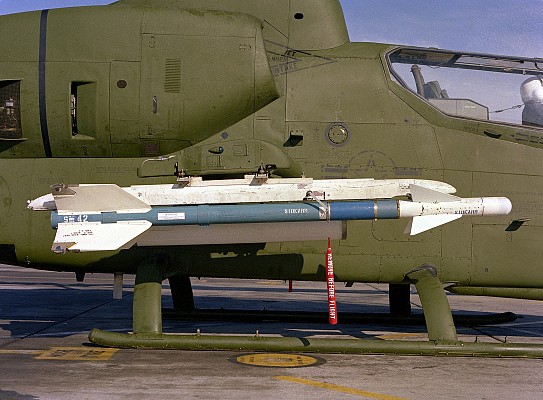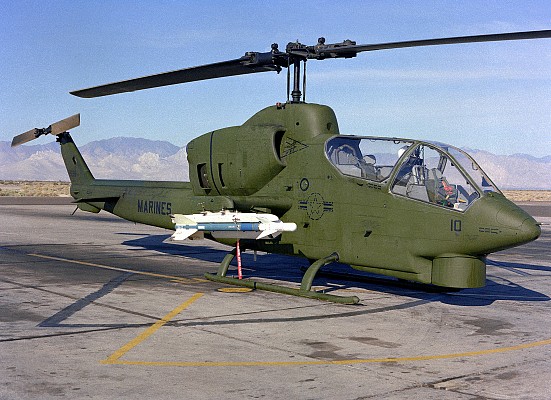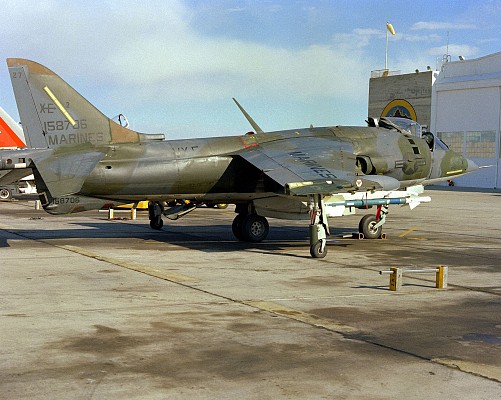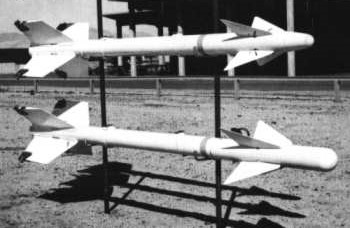AGM-122 Sidearm
Overview

AGM-122A Sidearm
AGM-122A Sidearm anti-radiation missile seen on a US Marine Corps AH-1T SeaCobra.
Source: US DoD -
© Public domain
1984
SideARM / Sidewinder Anti-Radiation Missile
Description
Introduction
The AGM-122 Sidearm is a late Cold War era anti-radiation missile of American origin. The name "Sidearm" refers to the Sidewinder missile and ARM acronym for Anti-Radiation Missile. The role for the AGM-122 was to engage short range air defense when attack helicopters or close air support aircraft encountered these systems on their mission.
Design
The AGM-122 Sidearm is a compact anti-radiation missile. It was produced by converting existing obsolete stocks of AIM-9C Sidewinder air to air missiles. This being the only Sidewinder variant to ever use semi-active radar homing, since all other variants use infrared homing. Conversion to the Sidearm missile included a new broadband radar seeker, and possible other modifications. There are conflicting sources on whether the rocket motor or warhead have been altered. Externally the Sidearm looks like early types of Sidewinder missile.
Guidance
The Sidearm uses passive radar homing to lock on to an enemy radar system. The original narrowband seeker was replaced by a broadband radar seeker. The broadband seeker will guide itself towards any source of radar emissions within the set bandwidth. Reportedly the bandwidth can be set by the launch aircraft to match the type or targets likely to be encountered. For helicopters (and perhaps aircraft as well) the bandwidth selection was set prior to the mission. The AGM-122 was never intended for a dedicated suppression of enemy air defenses mission, which requires longer range missiles with more sensitive seekers.
Firepower
There are conflicting reports on whether the continuous rod warhead of the AIM-9C was retained, or that it was exchanged for a blast fragmentation warhead. In any case a proximity fuse was added for airburst detonation. A proximity fuse was necessary since the seeker is not accurate enough to guarantee a direct hit. Also, radar dishes are fragile and may not trigger an impact fuse.
The effective range is limited by the 60 second guidance time for the seeker in combination with the launch altitude and airspeed. Intended for helicopters and close air support aircraft both altitude and speed are limited compared to air to air combat scenarios for the Sidewinder. For helicopter use a lofted trajectory could be selected. Theoretical maximum range for the original AIM-9C was 18 km. Maximum effective range for the AGM-122 is around 8 to 10 km, with practical ranges being even closer.
Platforms
The performance of the Sidearm was significantly lower than the AGM-88 HARM. The AGM-122 was carried as a lightweight self-defense addition to a ground attack loadout. As a much smaller missile it could also be launched from helicopters, a rather unique feature to this day. Aircraft that carried the Sidearm were the AV-8 Harrier and A-4 Skyhawk. Helicopter use was on the AH-1T SeaCobra and AH-1W SuperCobra.
Users
The sole user of the AGM-122 Sidearm was the US Marine Corps. It was used on both attack helicopters and aircraft used in the close air support role. All Sidearms missiles were produced by converting existing stocks of AIM-9C Sidewinder missiles. Plans to produce new built missiles as the AGM-122B never materialized.
Details
Media

AGM-122A Sidearm
AGM-122A Sidearm anti-radiation missile seen on a US Marine Corps AH-1T SeaCobra.
Source: US DoD -
© Public domain

AGM-122A Sidearm
AGM-122A Sidearm anti-radiation missile seen on a US Marine Corps AV-8A Harrier.
Source: US DoD -
© Public domain
Related articles

AIM-9C Sidewinder
The AGM-122A was produced by converting existing stocks of AIM-9C short range air to air missiles. Of the roughly 1.000 AIM-9C produced about 700 were converted to Sidearm.